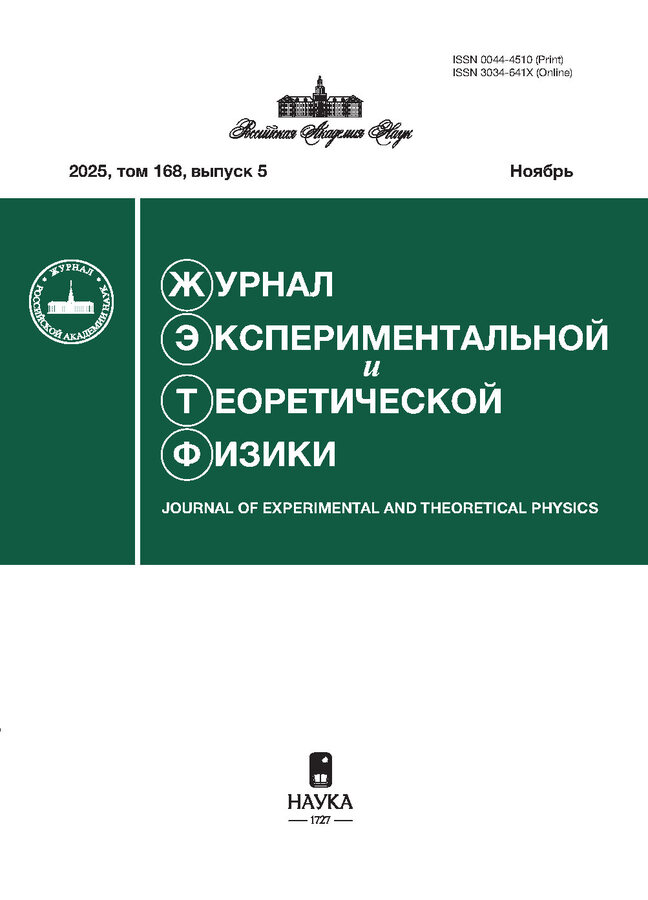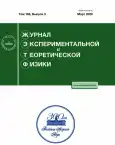Взаимодействие двух заряженных диэлектрических шаров с точечным зарядом
- Авторы: Родин М.М1,2,3, Филиппов А.В1,2,3
-
Учреждения:
- Московский физико-технический институт(национальный исследовательский университет)
- ГНЦ РФ Троицкий институт инновационных и термоядерных исследований
- Объединенный институт высоких температур Российской академии наук
- Выпуск: Том 163, № 3 (2023)
- Страницы: 321-334
- Раздел: Статьи
- URL: https://journals.rcsi.science/0044-4510/article/view/145269
- DOI: https://doi.org/10.31857/S0044451023030033
- EDN: https://elibrary.ru/QDIKKL
- ID: 145269
Цитировать
Полный текст
Аннотация
Рассмотрена задача о взаимодействии трех заряженных частиц, размером одной из которых можно пренебречь. Методом разложения пошаровым гармоникам найдены уравнения для коэффициентов разложения потенциала электрического поля. Получены выражения для декартовых компонент силы и момента силывзаимо действия. Показано,что несмотря на нарушение аксиальной симметрии при добавлении третьей частицы, при равномерной зарядке частицы сферической формы все компоненты вектора момента силы, действующей на нее, равны нулю. Путем выделения вкладов зарядов-изображений в явном виде получены формулы для поверхностной плотности заряда и силы взаимодействия частиц. Исследованы условия возникновения притяжения между одноименно заряженными сферическими частицами в зависимости от положения точечной.
Об авторах
М. М Родин
Московский физико-технический институт(национальный исследовательский университет); ГНЦ РФ Троицкий институт инновационных и термоядерных исследований; Объединенный институт высоких температур Российской академии наук
Email: fav@triniti.ru
141701, Dolgoprudny, Moscow oblast, Russia; 108840, Troitsk, Moscow, Russia; 125412, Moscow, Russia
А. В Филиппов
Московский физико-технический институт(национальный исследовательский университет);ГНЦ РФ Троицкий институт инновационных и термоядерных исследований;Объединенный институт высоких температур Российской академии наук
Автор, ответственный за переписку.
Email: fav@triniti.ru
Moscow Institute of Physics and Technology (National Research University); State Scientific Center of the Russian Federation “Troitsk Institute for Innovation and Fusion Research”; Joint Institute for High Temperatures, Russian Academy of Sciences
141701, Dolgoprudny, Moscow oblast, Russia; 125412, Moscow, Russia; 125412, Moscow, RussiaСписок литературы
- A.A. Sickafoose, J. E. Colwell, M. Horanyi, and S. Robertson, Phys.Rev.Let. 84, 6034 (2000).
- J.D. Sartor, J.Geophys.Res. 65, 1953 (1960).
- H.T. Ochs and R.R. Czys, Nature 327, 606 (1987).
- E.B. Lindgren, B. Stamm, H.-K. Chan et al., Icarus 291, 245 (2017).
- А.В. Филиппов, И.Н. Дербенев,ЖЭТФ 150, 1262 (2016).
- J.Q. Feng, Phys.Rev.E 62, 2891 (2000).
- M.H. Davis, Q. J.Mech.Appl.Math. 17, 499 (1964).
- J. Lekner, Proc.Roy. Soc.A 468, 2829 (2012).
- А. В. Филиппов, ЖЭТФ 136, 601 (2009).
- A.V. Filippov, Contrib.Plasma Phys. 49, 433 (2009).
- E. Bichoutskaia, A. L. Boatwright, A. Khachatourian, and A. J. Stace, J.Chem.Phys. 133, 024105 (2010).
- V. Jadhao, Z. Yao, C.K. Thomas, and M.O. De La Cruz, Phys.Rev.E 91, 032305 (2015).
- I. N. Derbenev, A. V. Filippov, A. J. Stace, and E. Besley, J.Chem.Phys. 152, 024121 (2020).
- В. Р. Муниров, А.В. Филиппов, ЖЭТФ 142, 594 (2012).
- A. Khachatourian, H.-K. Chan, A. J. Stace, and E. Bichoutskaia, J.Chem. Phys. 140, 074107 (2014).
- В. Р. Муниров, А.В. Филиппов, ЖЭТФ 144, 931 (2013).
- B.A. Tinsley, Rep. Prog. Phys. 71, 066801 (2008).
- В. В. Батыгин, И.Н. Топтыгин, Сборник задач по электродинамике, Наука, Москва (1970).
- В. Смайт, Электростатика и электродинамика, Изд-во иностр. лит., Москва (1954)
- W.R. Smythe, Static and Dynamic Electricity, McGraw-Hill, New York -Toronto - London, 2-nd edition (1950).
- J.D. Love, Q. J.Mech.Appl.Math. 28, 449 (1975).
- Y. Nakajima and T. Sato, J. Electrost. 45, 213 (1999).
- E. B. Lindgren, H.-K. Chan, A. J. Stace, and E. Besley, Phys. Chem. Chem. Phys. 18, 5883 (2016).
- E. B. Lindgren, A. J. Stace, E. Polack, Y. Maday, B. Stamm, and E. Besley, J. Comp. Phys. 371, 712 (2018).
- M. Hassan and B. Stamm, ESAIM: Mathematical Modelling and Numerical Analysis 55, S65 (2021).
- B. Bramas, M. Hassan, and B. Stamm, ESAIM: Mathematical Modelling and Numerical Analysis 55, S625 (2021).
- E. В. Гобсон, Теория сферических и эллипсоидальных функций, Изд-во иностр. лит., Москва (1952)
- E.W. Hobson, The Theory of Spherical and Ellipsoidal Harmonics, University Press, Cambridge (1931).
- Э.Т. Уиттекер, Д.Н. Ватсон, Курс современного анализа, ч. 2, Трансцендентные функции, Физматгиз, Москва (1963).
- Л.Д. Ландау, Е.М. Лифшиц, Теоретическая физика, т.VIII, Электродинамика сплошных сред, Наука, Москва (1982)
- L. D. Landau, E. M. Lifshitz, and L. P. Pitaevskii, Electrodynamics of Continuous Media, Vol. 8, Pergamon Press, Oxford (1984).
- N. Sato, AIP Conf. Proc. 799, 97 (2005).
- S. I. Krasheninnikov, Phys.Plasmas 13, 114502 (2006).
- S. I. Krasheninnikov, V. I. Shevchenko, and P.K. Shukla, Phys. Lett.A 361, 133 (2007).
- V.Y. Karasev, E. S.Dzlieva, A. I.Eikhval'd, M.A.Ermolenko, M. S. Golubev, and A.Y. Ivanov, Phys. Rev.E 79, 026406 (2009).
- S. I. Krasheninnikov, R.D. Smirnov, and D. L. Rudakov, Plasma Phys.Control. Fusion 53, 083001 (2011).
- Е. С. Дзлиева, В. Ю. Карасев, О. Ф. Петров, ЖЭТФ 14, 189 (2012).
- V.Y. Karasev, E. S. Dzlieva, S. I. Pavlov, L.A. Novikov, and I.C. Mashek, Technical Phys. 64, 42 (2019).
- L. Simons and A. Long, Phys.Plasmas 28, 093702 (2021).
- S. Ratynskaia, A. Bortolon, and S. I. Krasheninnikov, Rev.Mod. Plasma Phys. 6, 1 (2022).
- M. E. Rose, Elementary Theory of Angular Momentum, John Wiley & Sons, New York (1957).
Дополнительные файлы










